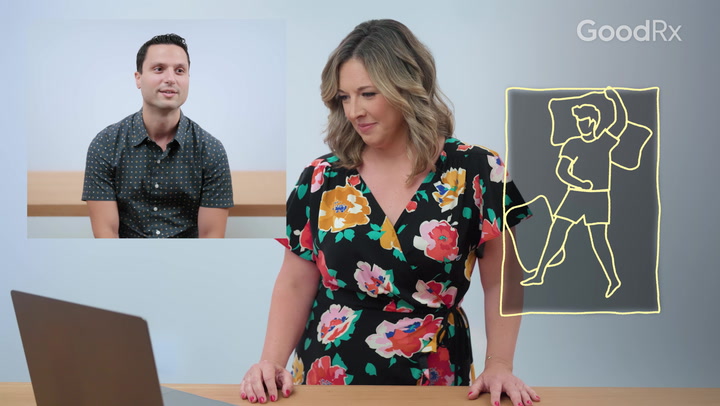
What You Need to Know About Chronic Obstructive Pulmonary Disease (COPD) Stages
Key takeaways:
Chronic obstructive pulmonary disease (COPD) is a long-term breathing condition that typically starts with mild symptoms and progresses over time.
COPD is staged from grade 1 to 4 according to how severely your lungs are affected.
In addition to your grade, you also get a letter — A, B, C, or D — according to the impact that COPD has on your symptoms and your health.
Stopping smoking is the best thing you can do to prevent COPD from worsening. Treatment with physical therapy and inhalers can help keep you feeling healthier for longer.
Table of contents

Chronic obstructive pulmonary disease (COPD) is a lung disease that causes shortness of breath, cough, tiredness, and frequent chest infections. At least 15.9 million people in the U.S. have COPD. But the actual number is likely much higher because many people with COPD don’t know they have it. This is because symptoms typically start out mild and gradually get worse over time. But that’s not the case for everyone. Some people with COPD can develop severe symptoms that quickly worsen over a short period of time.
COPD is staged according to the symptoms you feel and how well your lungs work (lung function). If you have COPD, you may wonder what the future looks like for you. Let’s take a closer look at the stages of COPD, the day-to-day symptoms you might feel, and how COPD can affect life expectancy.
What is COPD, and how does it affect the lungs?
COPD affects the small airways in the lungs and lung tissue. Despite the name, COPD is not a single disease. There are two main disease processes that occur in the lungs:
Chronic bronchitis: This is inflammation of the small airways, which can cause cough and mucus production.
Emphysema: This is damage to the elastic tissue in the lungs, which can cause breathlessness and noisy breathing (wheezing).
In real life, most people with COPD have a combination of emphysema and COPD.
What causes COPD?
Smoking is the leading cause of COPD. In fact, cigarette smoking causes up to 9 in 10 COPD cases. Repeatedly breathing in somebody else’s tobacco smoke, especially during childhood, also raises your risk for developing COPD. Exposure to air pollution, dust, and other chemicals can raise your risk for COPD as well.
In very rare cases, the genetic condition alpha-1-antitrypsin deficiency can also cause COPD. People with this disorder have low levels of a protein that normally protects the lungs. Without this protection, the lung tissue is damaged, which may result in COPD.
What are the stages of COPD?
COPD is staged by combining the GOLD (Global Initiative for Chronic Obstructive Lung Disease) grade number and the ABCD group letter. This combination describes how mild or severe your COPD is (your lungs), and how you are affected by it (your symptoms and quality of life).
GOLD grade
To figure out how severe your COPD is, a healthcare professional will measure your lung function. Based on your lung function, your COPD gets a GOLD grade:
Grade 1: mild COPD
Grade 2: moderate COPD
Grade 3: severe COPD
Grade 4: very severe COPD
How GOLD grade is measured
Your lung function is assessed through a spirometry test, measuring how well your lungs work. Specifically, it checks your FEV1 (forced expiratory volume in 1 second) — how much air you can blow out in 1 second after a deep breath.
Your FEV1 is compared to what's considered normal for someone of your age, sex, height, and ancestry. This gives your COPD a GOLD stage from 1 to 4.
ABCD group
The ABCD grouping scores how much your symptoms affect you and your life. To figure this out, your care team will use a tool like the COPD Assessment Test (CAT), which asks about breathlessness, cough, mucus, sleep, and energy levels. These details are important because the grade of your COPD doesn't always match how you feel.
Here are the letter groupings for your symptoms:
Group A: You have 0 to 1 exacerbations (flare-ups) and no hospitalizations per year, and your CAT score is less than 10.
Group B: You have 0 to 1 exacerbations and no hospitalizations per year, and your CAT score is 10 or higher.
Group C: You have 2 or more exacerbations per year, or a hospitalization, and your CAT score is less than 10.
Group D: You have 2 or more exacerbations per year, or a hospitalization, and your CAT score is 10 or higher.
How ABCD group is determined
Your COPD care team will assess your symptoms using the ABCD groups from the GOLD organization. There are two parts to this:
Symptom assessment: This uses tools like the eight-question CAT survey to learn more about your specific symptoms (like breathlessness, cough, mucus, sleep, and energy levels).
Frequency of illness: This is how often you experience COPD flare-ups. This helps predict your risk of future exacerbations and hospitalizations, which guides treatment decisions to prevent them.
What your COPD stage means
Your COPD care team will add your GOLD grade to your ABCD group to give you a COPD stage that is a number (1 to 4) followed by a letter (A, B, C, or D).
For example, you may have COPD grade 2, group A if you:
Have moderate COPD on your lung function
Have no more than 1 exacerbation a year without hospitalization
Get symptoms only during strenuous physical activity
Mild or moderate COPD typically is GOLD grade 1 or 2, with low symptom impact (group A or B). More severe COPD may be graded GOLD 3 or 4. A person with severe or very severe COPD would typically have a higher symptom impact.
Mild to moderate COPD | Severe to very severe COPD | |
GOLD grade | 1, 2 | 3, 4 |
ABCD group | A, B | C, D |
Of course in real life people can have mild COPD but many symptoms. Likewise, they can have severe COPD and not struggle much at all.
Using lung function and the impact of symptoms to grade COPD helps your care team get a sense of how COPD affects your lungs and you as a person. This helps to figure out which treatment plan is best for you and how to tailor specific treatments to your situation.
How quickly do COPD stages worsen?
COPD is a lifelong illness. So it often “progresses” (worsens) over time. But it’s hard to predict how quickly COPD may go from mild to severe in someone.
Early signs and symptoms of COPD
Early on, people with COPD often don’t have symptoms. Even if they have mild symptoms, they may chalk these up to aging. And while it’s true that breathing worsens with age, COPD causes breathing to worsen at a faster rate than is normal for aging.
Here are some of the mild symptoms that people may notice early on with COPD:
Shortness of breath with mild activity, such as walking up the stairs
A lingering cough that doesn’t go away
Coughing up mucus
Noisy breathing (wheezing)
Tightness in the chest, or feeling like you can’t breathe properly
Timeline of COPD stages
Some people can live with mild or moderate COPD for decades. Other people may be diagnosed with more advanced COPD and move to very severe disease much faster. Some of this comes down to genetics. But some of it is due to how much you smoke or smoked and the level of lung irritants you are exposed to.
Regular checkups and lung function tests with your care team will give you an idea of how stable (or progressive) your COPD is.
Although COPD typically gets worse over time, starting treatment earlier can help maintain lung function, make it easier to breathe, and let you continue doing what you want to do for a longer time. If you smoke, quitting smoking is the best thing you can do for your lungs, no matter how severe your COPD is.
COPD exacerbations
Sometimes, symptoms of COPD will suddenly get worse over the course of hours or days. This is a COPD exacerbation (flare-up). It can happen to anyone with COPD, at any stage. Exacerbations are usually triggered when someone has an infection or inhales an irritating substance.
Symptoms of a COPD exacerbation include:
More breathlessness or fatigue than usual
Loud wheezing sounds when you breathe
A new or worsening cough
New mucus in your cough, more mucus in your cough, or a change in color of your mucus
Confusion
What happens in end-stage COPD?
With very severe, end-stage COPD, it’s difficult to breathe even while resting, talking, and eating. You may have so much trouble breathing that you don’t feel able to leave your home.
Many people with end-stage COPD depend on supplemental oxygen (an oxygen tank).
People with end-stage COPD often use certain body positions to help them breathe. They may lean forward on their arms and use their neck and shoulder muscles to help with breathing. They may also purse their lips when they breathe out.
Other effects of end-stage COPD are:
Weight loss
A big, rounded or bulging chest (“barrel chest”)
Blue lips or fingers
More frequent and severe exacerbations
Life expectancy with COPD
The course of COPD varies greatly from person to person. Even if you have end-stage COPD, it’s hard to predict life expectancy. That’s because there’s more that comes into play than how severe your COPD is.
The BODE Score is a tool that healthcare providers can use to estimate life expectancy in people who are being treated for COPD. It combines four elements:
Body mass index (BMI): This is based on height and weight. Since people with COPD struggle to keep on weight, a BMI higher than 21 is linked with a longer life expectancy.
Obstruction of airflow: This is based on lung function.
Dyspnea: This is the medical term for breathlessness, and it’s measured by the mMRC questionnaire.
Exercise capacity: This measures how far you can walk in 6 minutes.
The BODE score is calculated by adding up the scores for each element. The total score ranges from 0 to 10. The higher the score, the shorter your life expectancy.
While the BODE score can give an idea of life expectancy, it’s not a guarantee for your specific situation. That’s because the BODE score is based on statistics and provides averages over large groups of people. Also, most of the participants in the studies were men, so experts aren’t sure how accurate the BODE score is for other groups of people.
How can you live longer with COPD?
If you have COPD, here are the two main things you can do to prolong your life expectancy:
Quit smoking, or don’t start smoking.
Use long-term supplemental oxygen if your oxygen level is already low at rest.
Getting a good treatment plan is also important. Medications, adequate nutrition, and pulmonary rehabilitation can help you feel better, too.
The bottom line
Chronic obstructive pulmonary disease (COPD) is a lifelong disease that makes it hard to breathe. It’s hard to predict how quickly COPD will worsen in someone. It depends on how advanced the COPD is at diagnosis, genetics, smoking history, and how well treatment works.
For some, COPD moves through its stages over decades. And people who are diagnosed and treated early can expect to live mostly normal, healthy lives. But that’s not the case for everyone. If you have COPD and still smoke, quitting smoking is the biggest step you can take to slow down the disease and prevent it from getting worse.
Why trust our experts?


References
American Lung Association. (2021). COPD causes and risk factors.
American Thoracic Society. (2018). Exacerbation of COPD. American Journal of Respiratory and Critical Care Medicine.
BMJ Best Practice. (n.d.) Global Initiative for Chronic Obstructive Lung Disease (GOLD) criteria.
Celli, B. R., et al. (2004). The body-mass index, airflow obstruction, dyspnea, and exercise capacity index in chronic obstructive pulmonary disease. The New England Journal of Medicine.
Global Initiative for Chronic Obstructive Lung Disease, Inc. (2020). Global strategy for the diagnosis, management and prevention of chronic obstructive and pulmonary disease.
My Lungs My Life. (n.d.). COPD assessment test.
My Lungs My Life. (n.d.). Medical research council dyspnoea (breathlessness) scale.
Sullivan, J., et al. (2018). National and state estimates of COPD morbidity and mortality — United States, 2014-2015. COPD Foundation.

























